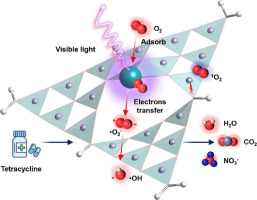--- 材料科学与工程学院-中文 ---

论文题目:Boosting the activation of molecular oxygen and the degradation of tetracycline over high loading Ag single atomic
论文作者:Zhiruo Zhou, Zhurui Shen*, Chunlin Song, Mingmei Li, Hui Li, Sihui Zhan

Abstract:
Photocatalytic activationofmolecularoxygen (O-2) is a promising way in oxidative degradationof organic pollutants. However, it suffers from low efficiency mainly due to the limited active sites for O-2 activationover traditional photocatalysts. Therefore, we established a singleatomicAg-g-C3N4 (SAACN) catalyst with 10 wt% loadingofAgsingle sites for boostingthe O-2 activation during thedegradationoftetracycline (TC), and 10 wt% loadingof nanoparticle Ag-g-C3N4 (NPACN) was studied as a comparison. When using SAACN, the accumulative concentration of superoxide (center dot O-2(-)), hydroxyl radical (center dot OH), singlet oxygen (O-1(2)) reached up to 0.66, 0.19, 0.33 mmol L-1 h(-1), respectively, within 120 min, 11.7, 5.7 and 4.9 times compared with those using NPACN, representing 17.24% of dissolved O-2 was converted to reactive oxygen species (ROS). When additionally feeding air or O-2, the accumulative concentrations of center dot O-2(-), center dot OH, O-1(2) were even higher (air: 4.21, 0.97, 2.02 mmol L-1 h(-1); O-2: 17.13, 1.32, 9.00 mmol L-1 h(-1). The rate constants (k) for degrading the TC were 0.0409 min(-1) over SAACN and 0.00880 min(-1) over NPACN, respectively (mineralization rate: 95.7% vs. 59.9% after 3 h ofdegradation). Moreover, thedegradation ability of SAACN did not decrease in a wide range of pH value (4-10) or under low temperature (10 degrees C). Besides thehigh exposure ofAgsingle sites, other advances of SAACN were: 1(O-2 was more energetic favorable to adsorb on singleatomicAg sites; 2) Positive Agsingle sites were easier to obtain the electrons from the surrounding N atoms, and facilitated electron transfer towards adsorbed O-2.
